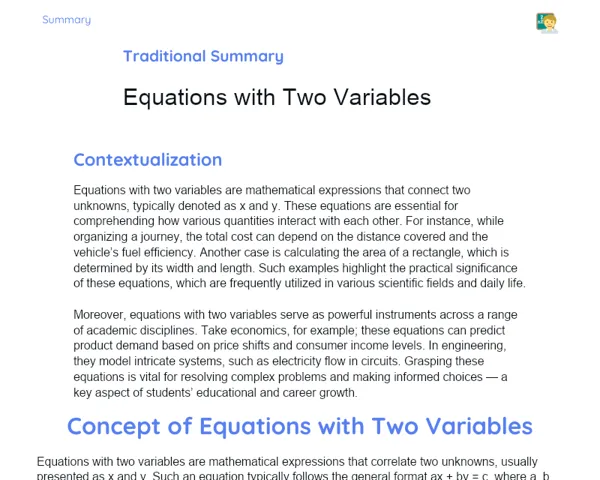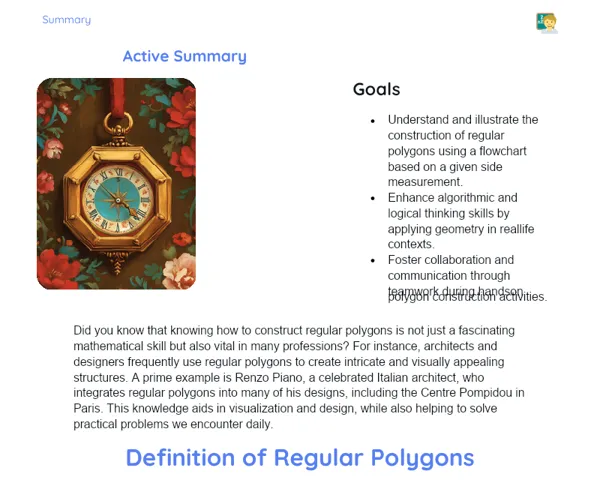Socioemotional Summary Conclusion
Goals
1. 🎯 Understand how to calculate the lateral surface area of a cylinder.
2. 🎯 Learn to calculate the total surface area of a cylinder.
3. 🎯 Develop problem-solving skills by applying these concepts to real-life situations.
Contextualization
🌟 Imagine you are an engineer designing a new soft drink can. To ensure the packaging is effective and cost-efficient, you need to know exactly how much material will be needed to cover the entire surface of the can, which is cylindrical in shape. Grasping spatial geometry helps us tackle real-world challenges, from construction projects to packaging design! 🚀
Exercising Your Knowledge
Definition of a Cylinder
A cylinder is a three-dimensional shape with two parallel circular bases and a curved surface connecting them. This shape finds its application in various contexts, like cans for beverages and structural columns in buildings.
-
🔹 Circular Base: The two bases are equal and parallel circles situated in different planes.
-
🔹 Curved Lateral Surface: Connects the two bases, forming a continuous surface around the cylinder.
-
🔹 Height (h): The vertical distance between the two circular bases, critical for area calculations.
Calculating Lateral Surface Area
Think of the lateral surface area of a cylinder as the label of a soft drink can, unwrapped and laid flat. We use the formula A_lateral = 2 * π * r * h, where r is the radius of the base and h is the height.
-
🔹 Formula:
A_lateral = 2 * π * r * his essential for finding the lateral area. -
🔹 Circumference Length:
2 * π * rgives us the circumference of the circular base. -
🔹 Application: This is crucial for solving practical challenges, such as wrapping cylinders.
Calculating Total Surface Area
To find the total surface area of a cylinder, we add the lateral area to the area of the two bases. The formula is A_total = A_lateral + 2 * A_base, where A_base = π * r^2.
-
🔹 Formula:
A_total = A_lateral + 2 * A_basecombines the lateral and base areas. -
🔹 Area of a Base:
A_base = π * r^2calculates the area of one of the circular bases. -
🔹 Sum: By adding the lateral area and the areas of the two bases, we find the total surface area of the cylinder.
Key Terms
-
Cylinder: A geometric solid featuring two parallel circular bases and a curved lateral surface.
-
Lateral Surface Area: The area of the outer surface around the cylinder, given by
2 * π * r * h. -
Total Surface Area: The combination of the lateral area and the areas of the bases, calculated as
A_lateral + 2 * A_base.
For Reflection
-
🌀 How did you manage your feelings when faced with a tough spatial geometry problem? What strategies helped you stay composed?
-
🤝 While working in groups, how did you collaborate with your classmates to solve problems? What social skills were important?
-
🧠 How has practising mindfulness improved your focus on problem-solving during lessons? Do you think this practice could be beneficial in other academic or personal scenarios?
Important Conclusions
-
📏 Recognize the definition of a cylinder and its key features, including circular bases and a curved surface.
-
🔍 Learn to compute the lateral surface area using the formula
A_lateral = 2 * π * r * h, as well as the total surface area usingA_total = A_lateral + 2 * A_base. -
🛠️ Apply these calculations in real-life situations, such as engineering and design, to address practical problems.
Impacts on Society
🌐 Understanding the surface area of cylinders has numerous applications across various industries and in the daily operations of many professions. For instance, engineers utilize these calculations for creating efficient designs and packaging solutions, while designers need to comprehend these measurements to develop functional and appealing products. This demonstrates how mathematics plays a vital role in technological and economic advancement.
😍 Moreover, the ability to tackle complex mathematical problems and manage challenges during the learning process aids in developing essential socio-emotional skills. Learning to stay calm and focused when facing mathematical difficulties can empower students to transfer these strategies to other aspects of their lives, fostering greater resilience and self-confidence.
Dealing with Emotions
🧘♂️ RULER Exercise: As you study the surface area of cylinders, pause to evaluate your feelings. Are you struggling with a challenging problem? Or perhaps feeling accomplished after solving it? Reflect on the underlying reasons for these feelings. Name your emotion precisely: is it anxiety, happiness, or confusion? Share these feelings, whether by chatting with a friend or jotting them down in a journal. Finally, find ways to regulate your emotions. If you're frustrated, step back to take a few deep breaths before diving back into your studies. Being aware of and managing your emotions will keep you focused and motivated, even when facing difficulties.
Study Tips
-
📚 Regular Practice: Dedicate a small amount of time each day to solve spatial geometry problems. Consistent, small efforts lead to large gains.
-
🧑🤝🧑 Collaborative Study: Team up with a friend or classmate to study. Engaging in discussions about problems and solutions can enhance understanding and make learning enjoyable.
-
🔍 Practical Applications: Look for ways to apply what you've learned in everyday situations. For instance, calculate the area of cylindrical shapes in everyday items you encounter.



